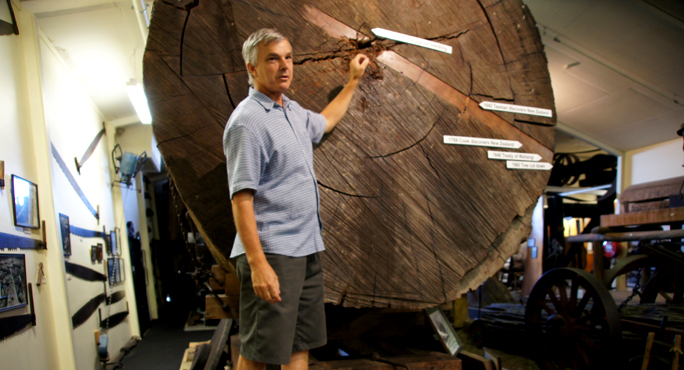New Zealand, biologist Dr. Jonathan Palmer at The Kauri Museum
At The Kauri Museum in Matakohe, New Zealand, biologist Dr. Jonathan Palmer explains a novel approach to assessing global climate change - by analyzing the rings of ancient kauri trees.
This work, published in the February 5th 2012 edition of the science journal Nature online, represents one more dimension of planetary climate assessment, and is already making a contribution to our understanding of how Earth’s climate has altered over the years.
The article, Multi-centennial tree-ring record of ENSO-related activity in New Zealand, was written by a Dr. Anthony Fowler, and a team of scientists, including Palmer. The term ENSO refers to El Nino/Southern Oscillation, a phenomenon of temperature change that shifts and changes on a global scale over time.
At one time, vast forests of kauri (Agathis australis) covered much of northern New Zealand. The majestic trees with immense crowns are unique to the northern island of New Zealand, and are now regarded as biological treasures. But over the past several centuries, both Maori natives and colonial settlers have burned down, cut down, or otherwise greatly reduced the population of kauri trees to approximately 3% of their former density. Today the few remaining ancient kauri trees are protected by environmental agencies, and are tourist attractions, much like the redwoods of California.
The kauri is a hardwood tree, and grows to a huge proportion. Some kauri trees have measured as much as fifty feet or more in diameter, yielding hundreds of tons of timber each. Especially in the 1800s and early 1900s, cutting down kauri trees for ship-building, home construction, and post wood was a big industry in New Zealand.
Some kauri trees grow for more than 1,500 years each, and as a result represent a biological storage space of information about climate history. Even more, many ancient kauri trees, dating as far back as 30,000 years, have been found well-preserved in swamps, enabling scientists to analyze climate history going back tens of thousands of years.
Scientists have known for a long time that tree rings indicate annual growth cycles. The width, color and composition of tree rings reveal information about environmental conditions, including temperature and atmospheric carbon dioxide levels. By analyzing samples of wood from the cores of ancient kauri trees, scientists have been able to establish certain cycles of global temperature, including very hot periods and very cold periods. With this information they have generated a climatic graph that covers several thousand years.
Today the issue of global climate change is a hot topic, and the key question is whether or not human activity is making a significant difference in global warming. According to the assessment of kauri rings presented in the Nature article, global temperature has risen at different periods over millennia. It also appears that in the twentieth century, significant warming of global climate has occurred. Evidence of this has been recorded by temperature measure with thermometers since their invention, and reaching back into longer history with ice-core drilling.
At the Kauri Museum, immense sections of kauri, as well as extensive photography of the former kauri timber industry, are on display. The photographic records available show vast forests that fed a hungry timber industry until most of the trees were gone and the industry collapsed. Today Jonathan Palmer is working on a project to help repopulate kauri trees, and to establish a sustainable kauri timber industry. But he’s just getting started.
Global climate impacts human health, wildlife, and all biological assets including food crops. Rising temperatures affect weather, and are altering life on a planetary scale. And it has branched into the realm of politics, becoming a very hot button issue. But a variety of scientific measures spanning long periods of time can shed light on global climate in a manner that political arguments cannot.
It may be that the assessment of kauri rings from ancient trees will help to clarify what remains a confusing and hotly disputed issue that affects us all.


